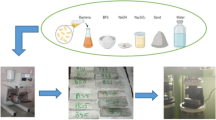Abstract
Free calcium oxide (f-CaO) in steel slag (SS) is considered to be the main reason for the volume expansion of steel slag, which has severely limited its application in cement or concrete. In this work, SS–cement pastes were prepared and hydrated under three different conditions. It was found that the hydration activity of f-CaO in steel slag and cement could be divided into three grades according to the hydration ratios under different hydration conditions. The high-activity f-CaO could undergo hydration reaction during the period of curing and would not participate in the expansion of hydration at a later stage. While the low-activity f-CaO would undergo hydration reaction during the boiling test and the lowest-activity f-CaO could not be hydrated except under autoclaving condition, both would participate in hydration expansion after the pastes hardened, thus leading to the poor volume stability of the pastes. Then, based on the fitting function of the experimental data and the extension of the mathematical model of hydration expansion, the contents of f-CaO with different activities in two kinds of SS were determined.







Similar content being viewed by others
References
H. Yi, G. Xu, H. Cheng, J. Wang, Y. Wan, and H. Chen, Procedia Environ. Sci. 16, 791 (2012).
Q. Wang and P. Yan, Constr. Build. Mater. 24, 1134 (2010).
Z. Chen, R. Li, and J. Liu, Constr. Build. Mater. 283, 122667 (2021).
P. Liu, J. Zhong, M. Zhang, M. Mo, and M. Deng, Constr. Build. Mater. 309, 125171 (2021).
Q. Song, M. Guo, L. Wang, and T. Ling, Resour. Conserv. Recycl. 173, 105740 (2021).
A.S. Brand and J.R. Roesler, Cem. Concr. Res. 86, 117 (2018).
L. Mo, F. Zhang, M. Deng, F. Jin, A. Al-Tabbaa, and A. Wang, Cem. Concr. Compos. 83, 138 (2017).
J. Zhao, P. Yan, and W. Wang, J. Clean. Prod. 156, 50 (2017).
Q. Wang, M. Shi, and Z. Zhang, Therm. Anal. Calorim. 120(2), 1241 (2015).
G. Wang, Y. Wang, and Z. Gao, J. Hazard Mater. 184, 555 (2010).
J. Hou, L. Yang, J. Liu, and Q. Wu, Mater. Struct. 51, 113 (2018).
R. Jia and J. Liu, Mater. Sci. Eng. 2016, 1 (2016).
X. Ji, J. Hou, Y. Liu, and J. Liu, Constr. Build. Mater. 225, 476 (2019).
Y. Weng, Y. Liu, and J. Liu, Environ. Technol. 42(18), 2776 (2020).
Q. Wang and P. Yan, Constr. Build. Mater. 24(7), 1134 (2010).
J. Du, J. Liu, and M. Li, PTCA (Part B Chem. Anal.) 49(8), 961 (2013).
I.W. Kimaru, A.T. Corigliano, and F. Zhao, J. Chem. Educ. 95, 2238 (2018).
B. Zhang, J. Hu, and M. Li, Appl. Mech. Mater. 507, 295 (2014).
B. Huo, B. Li, C. Chen, and Y. Zhang, Constr. Build. Mater. 280, 122500 (2021).
H. Zhang, H. Ogura, M. Umezu, T. Imai, and M. Ishii, J. Mater. Sci. 52, 11360 (2017).
Q. Wang, D. Wang, and S. Zhuang, Constr. Build. Mater. 151, 138 (2017).
Acknowledgements
This work was supported by the National Natural Science Foundation of China (Grant Nos. 52074019, 51874013).
Author information
Authors and Affiliations
Corresponding author
Ethics declarations
Conflict of interest
The authors declare that we have no conflict of interest.
Additional information
Publisher's Note
Springer Nature remains neutral with regard to jurisdictional claims in published maps and institutional affiliations.
Supplementary Information
Below is the link to the electronic supplementary material.
Rights and permissions
Springer Nature or its licensor (e.g. a society or other partner) holds exclusive rights to this article under a publishing agreement with the author(s) or other rightsholder(s); author self-archiving of the accepted manuscript version of this article is solely governed by the terms of such publishing agreement and applicable law.
About this article
Cite this article
Chen, T., Weng, Y., Liu, Y. et al. Calculation of f-CaO Hydration Ratio in Steel Slag Based on Mathematical Model of Hydration Expansion of Steel Slag–Cement Cementitious Materials. JOM 75, 5243–5251 (2023). https://doi.org/10.1007/s11837-023-05946-9
Received:
Accepted:
Published:
Issue Date:
DOI: https://doi.org/10.1007/s11837-023-05946-9




